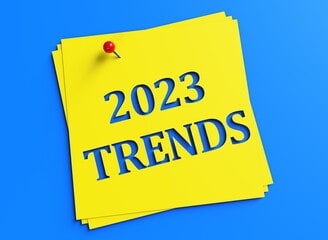
Unfolding Innovations: E-commerce Marketing Trends of 2023
In 2023, a unique blend of technology, customer preferences, and evolving business models are driving revolutionary changes in e-commerce marketing. In this dynamic realm of e-commerce, businesses that can anticipate and adapt to these trends have a competitive edge. Here are some of the key trends reshaping e-commerce marketing in 2023.
1. Augmented Reality (AR) and Virtual Reality (VR) E-commerce Experiences
The proliferation of AR and VR technology is changing the way consumers interact with products. These cutting-edge technologies allow customers to virtually try on clothes, place furniture in their living rooms, or explore product features in ways unimaginable a few years ago. The augmented e-commerce experience is no longer a novelty but an expectation, transforming online shopping from a passive activity into an interactive, engaging, and immersive experience.
2. Artificial Intelligence and Machine Learning
Artificial Intelligence (AI) and Machine Learning (ML) have emerged as central elements in e-commerce marketing strategies. By utilizing complex algorithms, AI and ML are capable of predicting purchasing behaviors, personalizing customer experiences, and even automating customer service responses. AI-powered recommendation systems are now ubiquitous, offering personalized suggestions based on individual consumer behavior and trends, thereby driving conversions and enhancing customer loyalty.
3. Voice Commerce
As voice assistant technologies like Amazon’s Alexa, Google Assistant, and Apple’s Siri continue to evolve, voice commerce is becoming a significant trend. Voice recognition technology has reached a level of sophistication that enables consumers to order products or services simply by talking to their smart devices. This effortless shopping experience is leading to an increase in voice-based purchases, making voice search optimization crucial for e-commerce businesses.
4. Social Commerce
Social media platforms are playing an increasingly vital role in e-commerce marketing. Social commerce, the direct selling of products within social media platforms, has exploded in popularity. Platforms like Facebook, Instagram, and TikTok have made it easy for businesses to sell directly to consumers through shoppable posts and in-app stores, eradicating the need to navigate away from the platform to complete a purchase. This seamless integration between social media and e-commerce platforms is resulting in increased sales and customer engagement.
5. Sustainability and Ethical Practices
Consumer awareness about environmental sustainability and ethical business practices has significantly increased, impacting purchasing decisions. As a result, e-commerce businesses that showcase their commitment to sustainability and ethical practices in their marketing strategies are likely to have an edge. Whether it’s through sustainable packaging, ethical sourcing, or carbon-neutral shipping options, e-commerce businesses are finding that green is not just a color, but a profitable marketing strategy.
6. Mobile Shopping and Mobile Payments
The rapid adoption of smartphones has led to an exponential increase in mobile shopping. E-commerce businesses are increasingly investing in mobile-friendly websites and apps to facilitate easy navigation and secure, frictionless mobile payment solutions. The use of digital wallets, like Apple Pay, Google Pay, and PayPal, has streamlined the checkout process, reducing cart abandonment and enhancing the mobile shopping experience.
7. Hyper-Personalization
Hyper-personalization, the practice of creating an individualized customer experience using AI and real-time data, is another significant trend. It extends beyond merely recommending products to offering personalized discounts, custom content, and predictive messaging based on the customer’s behavior, preferences, and real-time engagement. This high degree of personalization helps foster a deeper connection between the consumer and the brand, leading to improved customer retention and increased sales.
8. Omnichannel Marketing
Omnichannel marketing – the integration of various shopping channels into a cohesive, seamless customer experience – is becoming a standard e-commerce marketing strategy. Whether a customer shops online from a desktop or mobile device, over the phone, or in a brick-and-mortar store, the experience remains consistent and interconnected. This approach improves customer experience, fosters brand loyalty, and ultimately increases overall sales.
9. Data-Driven Marketing
In 2023, the use of big data is no longer an advantage, but a necessity for e-commerce businesses. Companies are leveraging data analytics to gain insights into consumer behaviors, preferences, and purchasing patterns, enabling them to tailor their marketing strategies accordingly. Furthermore, data-driven marketing helps businesses identify their most profitable customer segments, optimize pricing strategies, and make informed decisions about product selection and inventory management.
10. Live Streaming and Video Content
Live streaming and video content have become powerful tools in e-commerce marketing. Live streams allow businesses to showcase products in real-time, offer live demonstrations, and interact directly with consumers. They offer an immersive and interactive shopping experience that static images and text can’t match. Simultaneously, video content, whether in the form of product demos, tutorials, or customer testimonials, enhances product understanding and builds customer trust.
11. Dynamic Pricing
Dynamic pricing, a strategy where prices are flexible based on market demand, competition, and other variables, is being widely adopted in e-commerce. With the help of AI and real-time analytics, businesses can adjust prices at a micro-level to maximize sales and profit margins. This highly responsive pricing strategy not only improves competitiveness but also caters to customer price expectations and purchasing patterns.
12. D2C (Direct-to-Consumer) Model
The D2C model, where manufacturers sell directly to consumers bypassing traditional retailers or middlemen, is gaining momentum. This model allows businesses to control their brand narrative, improve profit margins, and build a more direct relationship with consumers. In a digital age where customers value authenticity and personalization, the D2C model is proving highly beneficial.
13. Localization of E-commerce
With the globalization of e-commerce, the importance of localization cannot be overstated. Businesses are increasingly customizing their websites, content, and marketing strategies to align with the local culture, language, and consumer preferences of different markets. This localization not only enhances the customer experience but also increases conversion rates and customer loyalty in diverse markets.
14. Advanced Delivery Options
Customer expectations about delivery are changing, and e-commerce businesses must adapt. Same-day delivery, secure pick-up points, real-time tracking, and flexible return policies are becoming standard. Additionally, drone delivery and autonomous vehicles are emerging as innovative delivery solutions, reducing delivery time and improving efficiency.
15. Blockchain Technology
Blockchain technology is beginning to make its presence felt in e-commerce. By providing secure, transparent transactions, blockchain offers an answer to many common e-commerce challenges, including fraud, counterfeit goods, and complex supply chains. While still in its early stages, blockchain’s potential to transform e-commerce is significant.

E-commerce marketing in 2023 is a fascinating blend of technology, data, and consumer-centered strategies. The future will undoubtedly bring even more innovation, and businesses that can stay ahead of these trends will be well-positioned to succeed in the ever-changing e-commerce landscape. The key lies in continuous adaptation, technology integration, and always prioritizing the customer experience.
In conclusion, e-commerce marketing in 2023 is a vibrant and rapidly evolving field. Businesses that embrace these trends and innovate their marketing strategies accordingly are set to thrive. As technology and customer expectations continue to evolve, the future of e-commerce marketing holds even more exciting possibilities. For e-commerce businesses, the key to success lies in understanding these trends, adapting quickly, and always keeping the customer’s needs at the forefront of their strategy. Also, you can read more such amazing blogs on Papaya Digitals.
Author Bio :
Mohan Kumar working as Content Manager at papayadigitals.com
